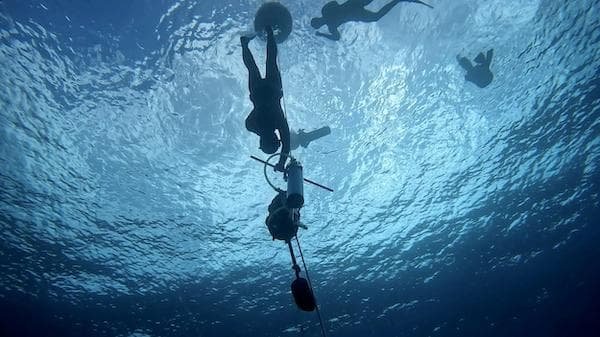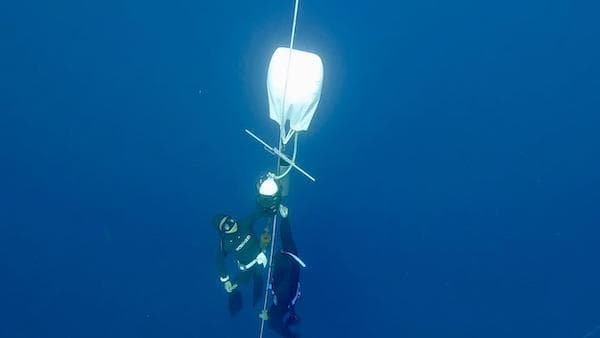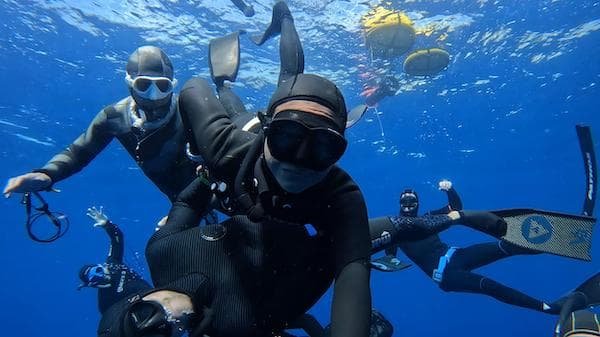In part two of this trilogy, we got to the end of my first month-long stay in Tenerife. I managed to dive to 39m, which surprised me greatly. However, the months following would see me struggling to get back to my Personal Best. Since I don’t live by the sea, and the British water is too cold for me anyway, I was traveling to different (warmer) places to dive between autumn 2021 to spring 2022. I was mostly diving in the range of 30-36m (though I did manage to complete three white card dives in a competition in Cyprus), and at some point, even 30m felt like a stretch (for example when diving in some Cenotes in Mexico where there was low light and bad visibility).
In May 2022, when I was training in Dahab, in the final session of a total of seven, I was finally able to get back to the previous depth and 1 meter more to arrive at 40m. I remember the two things I changed in my CWTB routine that resulted in the breakthrough (thanks to the coaches David McGoo and Federico Buzzoni): stop mask over-equalization (final equalization around 25), and “top up once and equalize many times” with Frenzel (essentially not dropping the tongue in between equalizations, so you can bring up air once around 30m and use that air to equalize all the way to 40m - I later learned that this is sort of similar to the later part of the mouthfill technique). I could feel the significance of these 2 things, which added 4 meters to my depth back then and could potentially add a bit more. I was also working very consciously on awareness and relaxation which helped. However, it didn’t feel like I had much more air left at the bottom, and my chest felt tight again (the “collapsed lung” feeling is back).
So these were the biggest challenges I was facing - the tightness in my chest and no more air for equalization as I approached 40 meters. Sometimes the blocking point came earlier, especially when I was not relaxed. And I was actively working on relaxation and trying to see if it goes away, but I find it a difficult thing to work on - how do you exert effort to give less effort? Anyway, this extended period of “struggle” also gave me the idea of “I am probably at the limit of my Frenzel equalization.” I didn’t expect myself to go any deeper with Frenzel.
Fast forward to Oct 2022, when I decided to go back to train in Tenerife, I went with the mind that I will not go deeper. My plan was to repeat the 40m dive until it feels more comfortable, and in the meantime perhaps learn to train some other disciplines such as FIM (I was mainly training CWTB after completing Level 1) or no-fins. It didn’t go as planned.
The day came unexpectedly when I got the chance to try No Limits. I remember one morning I went down to the dive center as usual, and Pavol the instructor said “you want to try No Limits today?” We had been talking about it a few times in the center, but I always thought it was a joke and didn’t expect to actually get the chance to try it myself. At the time my PB was about 42 and I was training to this depth on the days prior. I also just started learning the Mouthfill technique but had not tried to go deep with it yet.
I was so excited that I was jumping up and down. But at the same time, I was a bit nervous. What if I cannot equalize? What if the sled doesn’t stop when I wanted it to? What if I could not open the tank or there was no air (yes, I watched the Documentary about Audrey Mestre…) And how deep should I go? Should I try mouthfill which I was still completely unsure about, or stay with Frenzel which I know? What if I try too hard and have a squeeze? In the end, all my concerns turned out not to be an issue, and all the issues I actually had were things I didn’t even think about… More about that later.
So we set up the equipment in the center. Pavel talked through the whole setup with us. While we prepare we could ask questions to understand the equipment and process better. Then we headed out to the water. The plan was to do a shallow dive together with the instructor so we can learn to operate the sled, the balloon, and the tank, and then if everything goes well we can do individual dives to deeper depths.
I started with a warm-up hang as usual. It was a beautiful day with nice conditions, but I was excited and nervous that it was difficult to fully relax. The hang was lovely and calming. Then we went for the tandem dive. Everything happened very smoothly but fast, before I knew it I was holding onto the sled and we were going down. The line was awkwardly rubbing against my back at the beginning, but I soon adjusted to get away from it. Very quickly we hit the bottom of 20m. It was a very comfortable depth so I was very relaxed. I knew there were a lot of margins and in case something goes wrong I’d be able to easily go up. As previously instructed, I took out the balloon and opened the tank. The balloon was slowly filling up with air and we started to ascend. Our ascend picked up speed and my snorkel almost fell off. I let go of the sled before it hit the surface so that I don’t hit my head. Everything was so smooth and incredible! My mind felt much calmer and a lot of the anxiety went away now that I have experienced the process in a dive.

Next, I did independent dives to 30m, then 46, then 50! There was no effort going down so all I had to do was focus on relaxation and equalization. I was enjoying the ride down, and since the speed was much faster than my usual dives before I knew I was already at the bottom! There was no tension and no feeling of collapsed lungs at all. And contrary to my thought that I had hit my Frenzel barrier, I was able to Frenzel all the way to 50 and didn’t even feel the pressure in my chest like in a 40m dive!
A lot of people have said to me that relaxation is what makes the biggest difference - when you’re relaxed you don’t feel the chest pressure and can bring up more air and can reverse pack more easily. I believed this, but I never really experienced the magic of it so clearly and strongly as this time. The shocking difference in what I was able to do when my mind was not creating obstacles. What an amazing feeling and experience!
From there, in the subsequent training days, I was able to progress my PB from 42m to 45, 48, 50, 52, and 55. It was also the first time that I trained depth with FIM. When my FIM PB took over my CWTB PB, I thought to myself again about the power of the mind. What my mind was convinced I was NOT able to achieve was enough to stop me from achieving it. When the mental barrier was overcome, together with the right exercises and training, depth came naturally.

One thing worth mentioning was that I started doing a few lung stretches and FRC dives. Although it was only a few times before I tried the No Limits dive, they might have played a role in helping to improve the diaphragm flexibility which helped ease the chest pressure. The stretching exercises I did were some empty lung and full lung stretches I learned at Atlantis freediving (unfortunately I don’t have a video of this) and Harry’s stretching exercises.
Lastly, since depth adaptation takes time, I find that it works really well for me to stay somewhere and work remotely over a period of several weeks, take some vacation in the middle but also train on weekends so that it’s more of a continuous thing rather than a concentrated week of diving. It gave my body time to adjust and rest in between.
And the most important thing, is to enjoy the dives! I am very grateful to the instructors (such as Dave and Fede in Dahab) who really emphasized the importance of this. And this is particularly important at times when you might think you are not progressing or performing to the level you expect yourself to. I have also seen fellow freedivers being really harsh with themselves when they came up from a dive and did less time in the hang, or turned early. Remind yourself WHY you are diving. On my dive log of the last session in Dahab, I wrote the following:

“Feeling the relaxation, finding the good feeling of diving again…Remember that I am diving because I enjoy it. I dive to enjoy the dives themselves. No need to be harsh with myself when I feel like I am not performing. It doesn’t matter anyway. And it’s okay to take a rest step back and just enjoy the comfort zone for a bit and enjoy the ride and the scenery.“